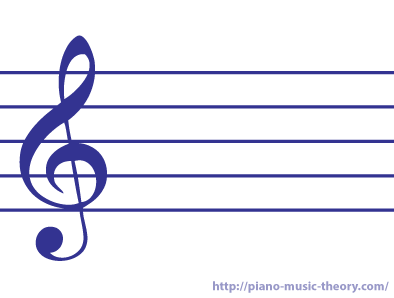The clef is the first symbol on the staff. After the clef, there is the key signature.
Key Signatures
The key signatures are the sharps or flats found in a particular music scale key.
For example, the key of G major scale [G – A – B – C – D – E – F♯ – G] has one F Sharp. The signature of the key of G major has one sharp on the F.

The key signature indicates that all of the F notes are sharp, and all other F notes in other octaves are also sharp.
If a natural symbol is placed to the left of one of the F note in one of the measure, that F note is played as a natural F note for the rest of the measure. After the measure ends, all F notes are to be played as F sharp again.
Because E minor is the relative minor of G major scale, the signature for the key of G major and E minor [E – F♯ – G – A – B – C – D – E] are the same.
If a key signature has no sharp or flat, it means that all notes are naturals.

The C major [C – D – E – F – G – A – B – C] and A minor [A – B – C – D – E – F – G – A] keys contain only natural notes, they have no sharp or flat. C major and A minor have the same relative keys and share the same key signature because A minor is the relative minor of C major.
List of All Major / Minor Key Signatures
Key signature with no sharp or flat:
C major / A minor
Sharp Key Signatures:
G major / E minor has one sharp: F♯
D major / B minor has two sharps: F♯ – C♯
A major / F Sharp minor has three sharps: F♯ – C♯ – G♯
E major / C Sharp minor has four sharps: F♯ – C♯ – G♯ – D♯
B major / G Sharp minor has five sharps: F♯ – C♯ – G♯ – D♯ – A♯
F Sharp major / D Sharp minor has six sharps: F♯ – C♯ – G♯ – D♯ – A♯ – E♯
C Sharp major / A Sharp minor has seven sharps: F♯ – C♯ – G♯ – D♯ – A♯ – E♯ – B♯
The Sharp Key Signatures Chart:

The sharp key signatures chart displays all sharps key signatures. All sharps appear in the following order in all sharp key signatures:
F – C – G – D – A – E – B

For example, D major and it’s relative minor B minor have two sharps: F♯ and C♯. F Sharp is the first sharp meaning that it is always written before the C Sharp in the key signature:

Flat Key signatures:
F major / D minor has one flat: B♭
B Flat major / G minor has two flats: B♭ – E♭
E Flat major / C minor has three flats: B♭ – E♭ – A♭
A Flat major / F minor has four flats: B♭ – E♭ – A♭ – D♭
D Flat major / B Flat minor has five flats: B♭ – E♭ – A♭ – D♭ – G♭
G Flat major / E Flat minor has six flats: B♭ – E♭ – A♭ – D♭ – G♭ – C♭
C Flat major / A Flat minor has seven flats: B♭ – E♭ – A♭ – D♭ – G♭ – C♭ – F♭

The Flat Key Signatures Chart:
The flat key signatures chart displays all flat key signatures. B – E – A – D – G – C – F is the order of flats in all flat key signatures. Notice that it is the backward of order of sharps [F – C – G – D – A – E – B].

How to determine the key from the number of sharps or flats in a key signature?
Major key – a quick way to determine the major key from a sharp key signature is to raise the last position sharp by a half step to get the major key.
If the key signature has flats, the major key is the name of the second-to-last flat. The only exceptions to this rule are F major and C major, because F major key has only one flat and C major has no sharp or flat.
Minor key – Remember that each major key shares a key signature with a minor key. This minor key is called the relative minor of the major key. For example, E minor is the relative minor of G major, they have the same key signature because E minor and G major have the same relative keys.